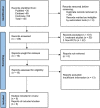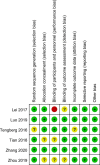Intravenous application of tranexamic acid in intramedullary nailing for the treatment of geriatric intertrochanteric fractures: a systematic review and meta-analysis
- PMID: 37501145
- PMCID: PMC10373423
- DOI: 10.1186/s12891-023-06725-y
Intravenous application of tranexamic acid in intramedullary nailing for the treatment of geriatric intertrochanteric fractures: a systematic review and meta-analysis
Abstract
Background: Meta-analyses on the use of tranexamic acid (TXA) in intertrochanteric fractures have shown inconsistent results due to variations in inclusion criteria and clinical heterogeneity. To address these limitations, we conducted a rigorous analysis of recent randomized controlled trials (RCTs) with strict inclusion criteria. The aim of this study was to objectively evaluate the effects and safety of intravenous TXA administration in the treatment of geriatric intertrochanteric femoral fractures with intramedullary nailing.
Methods: PubMed, Embase, and the Cochrane Library were searched for RCTs published from the database inception to August 2022. The date of total blood loss (TBL), intra-operative blood loss (IBL), hidden blood loss (HBL), transfusion rate, transfusion units, thromboembolic events, and mortality were extracted. Review Manager 5.3 was used for the analysis.
Results: A total of six RCTs involving 689 patients were included. Meta-analyses indicated that TXA can significantly reduce TBL (WMD = -232.82; 95% CI -312.81 to -152.84; p < 0.00001), IBL (WMD = -36.33; 95% CI -51.38 to -21.28; p < 0.00001), HBL (WMD = -189.23; 95% CI -274.92 to -103.54; p < 0.0001), transfusion rate (RR = 0.53; 95% CI 0.33 to 0.85; p = 0.008), and transfusion units (WMD = -0.58; 95% CI -0.75 to -0.41; p < 0.01). No increase in thromboembolic events rate (RR = 0.75; 95% CI 0.38 to 1.50; p = 0.42) and mortality (RR = 1.36; 95% CI 0.61 to 3.04; p = 0.45) was observed.
Conclusions: Our meta-analysis provides robust evidence supporting the efficacy and safety of intravenous TXA administration in treating geriatric intertrochanteric femoral fractures with intramedullary nailing. TXA significantly reduces blood loss and transfusion requirements without increasing the risk of thromboembolic events or mortality.
Keywords: Intertrochanteric fracture; Intramedullary nailing; Intravenous application; Tranexamic acid.
© 2023. The Author(s).
Conflict of interest statement
The authors declare that they have no competing interests.
Figures










Similar articles
-
Postoperative outcomes of tranexamic acid use in geriatric trauma patients treated with proximal femoral intramedullary nails: A systematic review and meta-analysis.Orthop Traumatol Surg Res. 2020 Feb;106(1):117-126. doi: 10.1016/j.otsr.2019.10.015. Epub 2020 Jan 9. Orthop Traumatol Surg Res. 2020. PMID: 31928976
-
Topical tranexamic acid in intramedullary nailing for the treatment of intertrochanteric fractures in the elderly: A protocol for systematic review and meta-analysis.Medicine (Baltimore). 2023 Feb 10;102(6):e32854. doi: 10.1097/MD.0000000000032854. Medicine (Baltimore). 2023. PMID: 36820553 Free PMC article.
-
Efficacy and safety of tranexamic acid for reducing blood loss in elderly patients with intertrochanteric fracture treated with intramedullary fixation surgery: A meta-analysis of randomized controlled trials.Acta Orthop Traumatol Turc. 2020 Jan;54(1):4-14. doi: 10.5152/j.aott.2020.01.88. Acta Orthop Traumatol Turc. 2020. PMID: 32175891 Free PMC article.
-
A single dose of tranexamic acid infusion is safe and effective to reduce total blood loss during proximal femoral nailing for intertrochanteric fractures: A prospective randomized study.Ulus Travma Acil Cerrahi Derg. 2022 Nov;28(11):1627-1633. doi: 10.14744/tjtes.2022.67137. Ulus Travma Acil Cerrahi Derg. 2022. PMID: 36282170 Free PMC article. Clinical Trial.
-
Efficacy and safety of intravenous tranexamic acid administration in patients undergoing hip fracture surgery for hemostasis: A meta-analysis.Medicine (Baltimore). 2017 May;96(21):e6940. doi: 10.1097/MD.0000000000006940. Medicine (Baltimore). 2017. PMID: 28538384 Free PMC article. Review.
Cited by
-
Identification of risk factors and development of a high-performance predictive model for non-healing in elderly patients with intertrochanteric fractures post-internal fixation.Am J Transl Res. 2025 Jul 25;17(7):5766-5778. doi: 10.62347/KFRM4177. eCollection 2025. Am J Transl Res. 2025. PMID: 40821067 Free PMC article.
-
Tranexamic acid: single topical application for femoral neck fractures treated with arthroplasty results in lowest blood loss.Eur J Trauma Emerg Surg. 2025 Jan 21;51(1):31. doi: 10.1007/s00068-024-02675-9. Eur J Trauma Emerg Surg. 2025. PMID: 39838163 Free PMC article.
-
Evaluation of the Early Administration of Tranexamic Acid in Geriatric Hip Fractures in the Emergency Department: A Retrospective Study.Cureus. 2024 Jun 18;16(6):e62636. doi: 10.7759/cureus.62636. eCollection 2024 Jun. Cureus. 2024. PMID: 39036146 Free PMC article.
-
Medial lag screw migration in an intramedullary nail combination.BMJ Case Rep. 2025 Mar 3;18(3):e262436. doi: 10.1136/bcr-2024-262436. BMJ Case Rep. 2025. PMID: 40032573 Free PMC article.
-
Bibliometric and visualized analysis on hip fracture surgery and venous thromboembolism.Heliyon. 2024 Aug 13;10(16):e36222. doi: 10.1016/j.heliyon.2024.e36222. eCollection 2024 Aug 30. Heliyon. 2024. PMID: 39247301 Free PMC article.
References
-
- Ma H, Wang H, Long X, Xu Z, Chen X, Li M, et al. Early intravenous tranexamic acid intervention reduces post-traumatic hidden blood loss in elderly patients with intertrochanteric fracture: a randomized controlled trial. J Orthop Surg Res. 2021;16(1):106. doi: 10.1186/s13018-020-02166-8. - DOI - PMC - PubMed
Publication types
MeSH terms
Substances
Grants and funding
LinkOut - more resources
Full Text Sources
Medical
Research Materials

